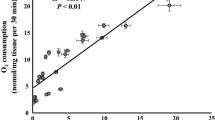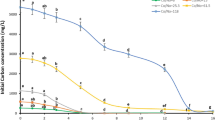Summary
-
1.
Cirolana borealis utilises glycogen during anaerobiosis and shows a marked Pasteur effect. In 18h, 20–30 mg/g dry weight were converted, about half of the initial total glycogen content (Table 1).
-
2.
Lactate is the major end product, while succinate and alanine are minor end products. 27–52% of the lactate produced was excreted into the incubation water (Tables 2 and 3). A good stoichiometric relationship was obtained between the glycogen consumed and the accumulation of these end products.
-
3.
Small amounts of glutamate and aspartate contribute to the carbon flow, which could be of significance for obtaining redox balance (Table 3).
-
4.
ATP production during anoxia was 75% of that during the standard aerobic state.
-
5.
It is concluded that anaerobic fermentative metabolism ofC. borealis is adapted to maintain a high ATP output per unit time, which suits the high energy demand under natural anaerobic conditions.
-
6.
WhenC. borealis are subjected to experimental anoxia they expel their gut contents and the incubation water becomes enriched with acetate, propionate, and amino acids. Most of these compounds probably stem directly from the gut content, while some, like acetate, may be produced by microbial activity. Starvation and anaerobic preincubation resulted in a marked lowering of the amounts of these compounds in the incubation water.
Similar content being viewed by others
References
Barnes, H., Barnes, M., Finlayson, D.M.: The metabolism during starvation ofBalanus balanoides. J. Mar. Biol. Ass. U.K.43, 213–223 (1963)
Barnes, H., Barnes, M.: Some relations between the habitat, behaviour and metabolism on exposure to air of the high-level intertidal cirripedeChthamalus depressus (Poli). Helgoländer Wiss. Meeres10, 19–27 (1964)
Collicutt, J.M., Hochachka, P.W.: The anaerobic oyster heart: Coupling of glucose and aspartate fermentation. J. comp. Physiol.115, 147–157 (1977)
Grieshaber, M., Gäde, G.: The biological role of octopine in the squid,Loligo vulgaris (Lamarck). J. comp. Physiol.108, 225–232 (1976)
Grieshaber, M., Gäde, G.: Energy supply and the formation of octopine in the adductor muscle of the scallop,Pecten jacobaeus (Lamarck). Comp. Biochem. Physiol.58B, 249–252 (1977)
Hammen, C.S.: Lactate oxidation in the upper-shore barnacleChthamalus depressus (Poli). Comp. Biochem. Physiol.43A, 435–441 (1972)
Jamieson, D.D., Taylor, R.S., Taylor, K.M.: Energy metabolism in the lateral depressor muscle of the barnacleBalanus nigrescens. Comp. Biochem. Physiol.58B, 315–320 (1977)
Kluytmans, J.H., Veenhof, P.R., Zwaan, A. de: Anaerobic production of volatile fatty acids in the sea musselMytilus edulis L. J. comp. Physiol.104, 71–78 (1975)
Kluytmans, J.H., Bont, A.M.T. de, Janus, J., Wijsman, T.C.M.: Time dependent changes and tissue specificities in the accumulation of anaerobic fermentation products in the sea musselMytilus edulis L. Comp. Biochem. Physiol.58B, 81–87 (1977)
Schöttler, U., Schroff, G.: Untersuchungen zum anaeroben Glykogenabbau beiTubifex tubifex M. J. comp. Physiol.108, 243–254 (1976)
Skjoldal, H.R., Bakke, T.: Anaerobic metabolism of the scavenging isopodCirolana borealis (Lilljeborg). Adenine nucleotides. Twelfth European symposium on marine biology. McLusky, D.S., Berry, A.J. (eds.), pp. 67–74. Oxford: Pergamon Press 1978a
Skjoldal, H.R., Bakke, T.: Relationship between ATP and energy charge during lethal metabolic stress of the marine isopodCirolana borealis. J. Biol. Chem. (in press) (1978b)
Surholt, B.: Production of volatile fatty acids in the anaerobic carbohydrate catabolism ofArenicola marina. Comp. Biochem. Physiol.58B, 147–150 (1977)
Taylor, E.W., Butler, P.J., Al-Wassia, A.: Some responses of the shore crab,Carcinus maenas (L.) to progressive hypoxia at different acclimation temperatures and salinities. J. comp. Physiol.122, 391–402 (1977)
Zebe, E.:In vivo Untersuchungen über den Glukoseabban beiArenicola marina (Annelida, Polychaeta). J. comp. Physiol.101, 103–145 (1975)
Zwaan, A. de: Anaerobic energy metabolism in bivalve molluscs. Oceanogr. Mar. Biol. Ann. Rev.15, 103–187 (1977)
Zwaan, A. de, Wijsman, T.C.M.: Anaerobic metabolism in Bivalvia (Mollusca). Characteristics of anaerobic metabolism. Comp. Biochem. Physiol.54B, 313–324 (1976)
Zwaan, A. de, Zandee, D.I.: The utilization of glycogen and accumulation of some intermediates during anaerobiosis inMytilus edulis L. Comp. Biochem. Physiol.43B, 47–54 (1972)
Author information
Authors and Affiliations
Additional information
With technical assistance of P.R. Veenhof and H.J.L. Ravestein
Rights and permissions
About this article
Cite this article
de Zwaan, A., Skjoldal, H.R. Anaerobic energy metabolism of the scavenging isopodCirolana borealis (Lilljeborg). J Comp Physiol B 129, 327–331 (1979). https://doi.org/10.1007/BF00686989
Accepted:
Issue Date:
DOI: https://doi.org/10.1007/BF00686989




